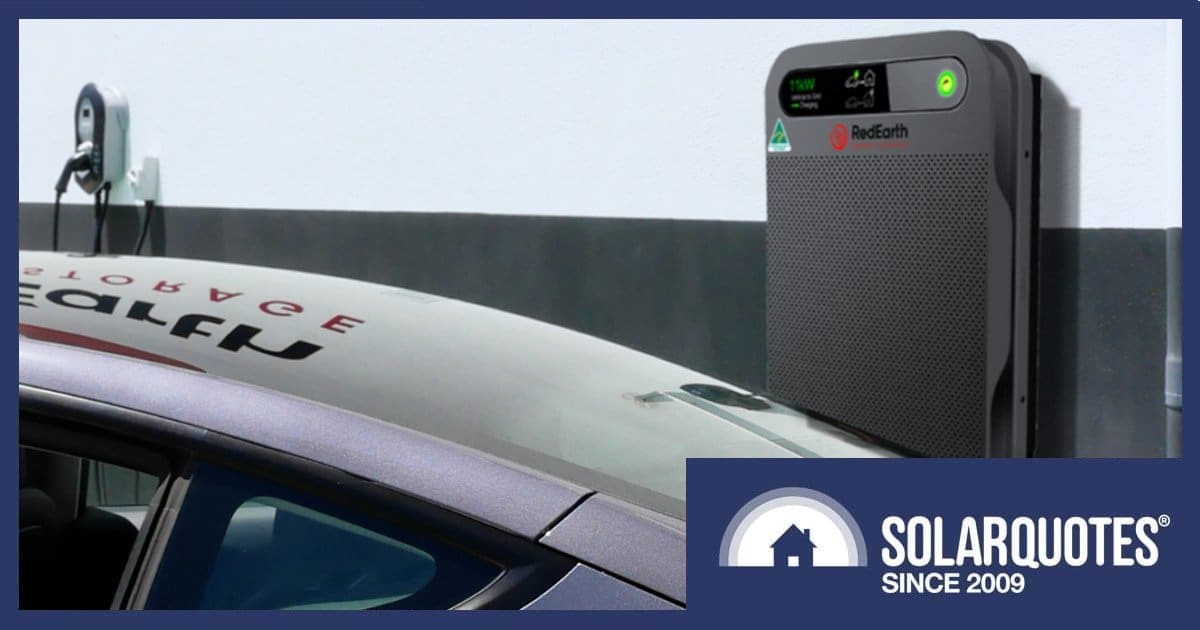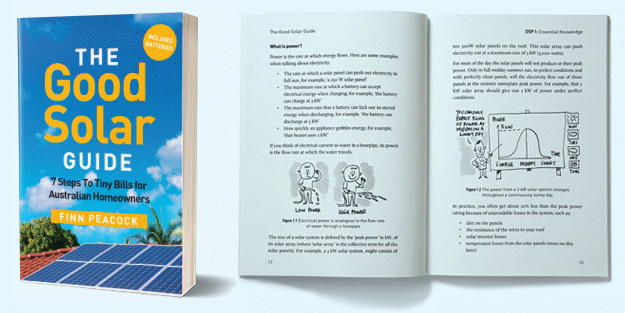Brisbane-based energy storage and EV charger firm RedEarth has provided a progress update regarding its Australian-made V2G bi-directional EV charger. Find out when it should be available — and brace yourself for the price.
RedEarth V2G Charger: What, When And How Much?
The RedEarth V2G charger will enable owners of compatible EVs to power their home with their car’s battery (Vehicle to Home – V2H) and export power back to the grid from it (Vehicle to Grid – V2G).
“For homeowners participating in the energy market, this feature will also allow EV batteries to interact with the wholesale market, charging when electricity prices are low or in negative territory, and discharging to generate revenue when prices are high,” said Red Earth CEO Marc Sheldon.
The company will manufacture the chargers at its factory in Brisbane. RedEarth has said pre-ordering for the 11kW three-phase bi-directional model kicks off next month, with customer deliveries expected to commence in February 2026. The 11kW three-phase unit will be followed by a 7.4 kW single-phase charger, and then a commercial 22 kW three-phase model. Timing of availability on those isn’t clear.
V2 Charger Cost
The 11kW three-phase charger will retail for $9,990 ex GST — or $10,989 with GST — and that’s before installation.
While an EV charger install can be as little as a few hundred dollars, the cost depends on complexity. Generally speaking, most can expect to pay between $1000 – $1,500 for installation of a charger in addition to the hardware cost.
Specs And EV Compatibility
RedEarth announced last year it had partnered with German firm Ambibox for the manufacture of its DC V2G bi-directional EV chargers here in Australia.
While RedEarth doesn’t have a datasheet for the device yet that I could find, a preliminary one for Ambibox’s Ambicharge 11 kW Home BiDi DC Wallbox (also not quite ready for prime time), can be found here. Just bear in mind specs could differ.
As for compatibility and according to information on RedEarth’s website, Ambibox has completed official testing with Ford, VW and Polestar, and carried out its own successful testing with electric vehicles such as the Hyundai Ioniq 5, BYD Atto 3, MG4, BMW i4 and Tesla Model Y.
Most of these vehicles aren’t officially noted as supporting V2H/V2G currently, so what gives?
How Does It Work?
While Ambibox doesn’t explain much on its website, according to a commenter on our previous post about the charger:
“My understanding is what ambiBox have been up to is building bi-directional DC chargers that are able to push/pull DC power directly to/from the traction battery in the car via the CCS2 charging port. An inverter and rectifier inside the wall box converts to/from AC to supply power to/draw power from the grid, apparently including 3-phase if you’ve got it.
Because they’re DC chargers they are not reliant on the car having a V2L inverter, nor do they need to be compatible with the car’s built in AC charger, they bypass all of that.”
What About EV Warranty Issues?
Just because an EV may unofficially support V2H/V2G, it doesn’t mean using it for these applications will be permitted in terms of EV warranty coverage. An official list of manufacturers that have or will sign off on V2H/V2G use with this charger in Australia remains to be seen.
RedEarth says:
“While we believe the use of bidirectional charging at the levels of the chargers we will be supplying (7.4 kW, 11 kW, and 22 kW) generally has significantly lower impact on battery health than normal driving would, some car manufacturers might not share our view and might block bidirectional charging.”
Learn more about V2L, V2G, V2H and V2X bi-directional charging here, and everything else you need to know about home EV chargers here.
Batteries: New Generation Gecko & Troppo Ultra
Over to home batteries and also announced last week was an update on RedEarth’s latest generation Gecko all-in-one energy storage system, and the Troppo Ultra — 5.6 kWh (nominal capacity) energy storage modules for use with the company’s battery systems.
The new Gecko will available next month and can house up to eight currently-available Troppo batteries for a total nominal capacity of 32.8 kWh (29.5 kWh useable) . But when the Troppo Ultra becomes available early next year ( pending CEC approval), maximum nominal storage capacity will be lifted to 44.8 kWh. The new Gecko will be available in single-phase (5 kW, 8 kW or 10 kW) and three-phase (12 kW or 15 kW) configurations.
“The Gecko has been designed for simplicity and speed of installation, helping installers respond to the increased market demand driven by the Cheaper Home Batteries Program,” said Sheldon. “When paired with our Private Power Plant platform, customers gain complete control over their energy, giving them the opportunity to participate in the energy market. They can choose how they store, trade or share their energy for greater energy independence.”
Thinking about a solar battery? See the SolarQuotes guide to home batteries that includes a comparison table where you can see how various models stack up side-by-side on specifications and approximate pricing.


 RSS - Posts
RSS - Posts



That price makes zero sense.
Why would you spend $10k+ more than a regular (smart) charge station when you can instead buy 30+ kWh of stationary storage dedicated to the task of powering a home?
I’m sure there will be a niche but I can’t see this gaining much traction with such a high price.
And no mention of its operational smarts / how it is integrated/controlled within a home’s energy systems?
I 100% agree. You can install a 40kwh Sygenergy battery with a 20kw inverter and full power outage back up for around 20k. Why would you pay 11k plus installation and have to rely on your EV?? This is a big fail from a company who indicated this would be released in June at half the price.
The only question I have is that the voltage is limited to 750 or 800v DC? Will this be compatible with vehicles being released now with 1000V or even 1200v DC bus?
I would say that this is good news.
Why it wouldn’t?
Very versatile bidirectional home charger allowing even DC charging, made and serviced in Australia, it will allow even the renters to power their houses with electricity from car’s battery, provided that the landlord will be willing to fork $10k+.
As someone who owns solar, a home charger and an EV, I think that the timing is essential.
The most economical is to charge the EV during the day, at home for free.
If you are at work during the day and charge the EV at public chargers, it is not economical to power your house from the EV during the night.
Off-peak electricity is cheaper, but dirtier.
Also the high cost of the charger means that paying it off will be, ballpark figure, 10-15 years, way longer than the warranty. And by then it will be very obsolete.
So, the appeal for V2H, let alone V2G is very limited to those who are at home during the day, have money to burn and waiting to make a buck from selling electricity to the grid.
Economical V2H/V2G, using the on-board inverter is a bit limited on the MG4, I figure. It inherently offers around 2.5 kW AC V2L via a CCS2 to 3-pin plug cord, if memory serves. That’s enough for fridge/freezer power and lights/internet in a blackout, though.
Much higher power draw, via the DC pins on the CCS2 connector and a wallbox inverter, opens options, but can arbitrage pay off the massive cost of the unit? Quite bit of (subsidised) house battery can be added for that, leaving the BEV ready to travel, not a physically stranded asset.
Still, if the option helps move the great mass of recalcitrants off ICE to BEV, then it’s a positive step. But given the predominance of range anxiety, I’d be spending the extra $10k on a longer range BEV, or a bigger home battery. (But then, a semi-remote rural resident would say that.)
I heard their owner speak many years ago on an engineer’s Australia interview and was quite interested in using them when I could finally afford solar and a battery.
But when I finally could, their offering was pretty poor compared to competitors and I went elsewhere.
So it’s good to see they are still in the game.
The price makes no sense at all.
I got a 42kwh battery, 15kw 3 phase inverter (DC coupled incl backup circuits) and a 22kw AC charger for a little less than $9k installed.
With the current battery rebate that product is DOA. You pay more for a product that degrades your car battery quicker and in turn reduces resale value quicker. Whereas a dedicated Home battery gets subsidies and when one of the stacks dies you simply remove one of the modules.
Too expensive at those prices, makes better sense to put in a home battery with the subsidies. For lots of people their EV would not be at home during the day to charge up from their solar, and the extra discharging of your EV’s battery every night, could shorten your EV’s battery life.
1 phase anyone ?